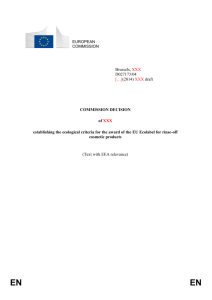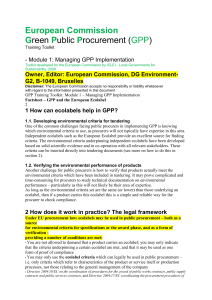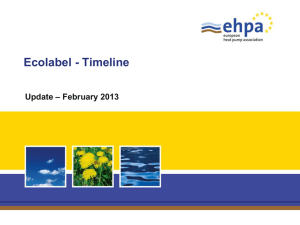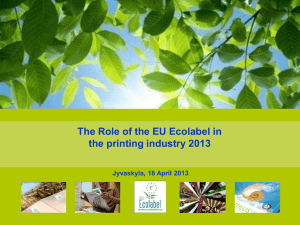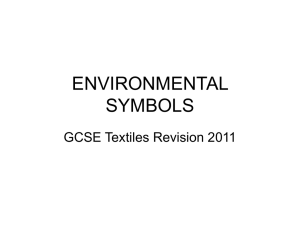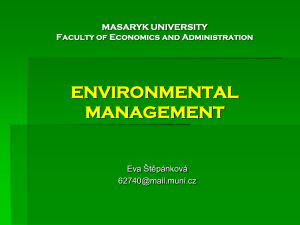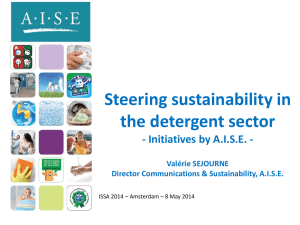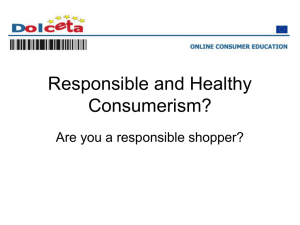GLOBAL ECOLABEL MONITOR TOWARDS TRANSPARENCY
advertisement
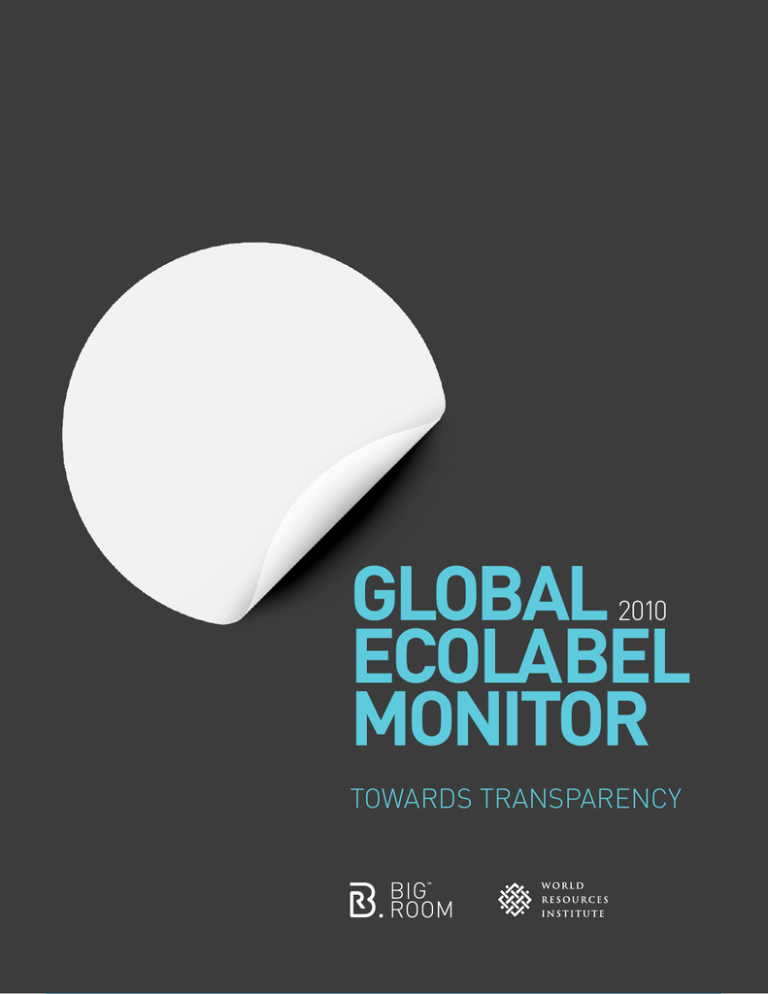
/ 01 2010 GLOBAL ECOLABEL MONITOR GLOBAL ECOLABEL MONITOR 2010 TOWARDS TRANSPARENCY / 01 2010 GLOBAL ECOLABEL MONITOR In November 2009 over 340 ecolabels in 42 countries were invited by the World Resources Institute and Big Room Inc to complete a comprehensive survey on their performance and organisational structure. The complete output of the survey will be published to www.wri.org with a searchable website at www.ecolabelindex.com in June 2010. / 02 2010 GLOBAL ECOLABEL MONITOR / SUMMARY RESULTS 340 ecolabels were surveyed. Of these: 33% completed the survey, 42% could not be reached, 14% started but did not finish, and 10% declined to participate. Of those that completed the survey: 17% used tiers (e.g. gold, silver, bronze) 71% used a pass/fail system. Some used both. 92% require certification before a ecolabel can be used. Of these, 66% use third-party certification. Most were run by non-profit (58%) and for-profit (18%) organisations. 8% were government run. Other types made up the rest. 44% have measured the environmental or social impacts of their labeling program and 21% plan to study them. Almost half (47%) are currently developing new standards. 88% make who or what they have certified public. 87% make their certification criteria public. Note: data accessibility and quality was not covered. Funding constraints for operations and marketing are the biggest hindrance to expansion and rigor. There is a wide range in both the sources of funding and pricing of licensing fees. Average time to obtain a certification is 4 months, but there was wide variation in this. Average certificate duration is 2 years. Non-profit ecolabels tended to use more rigorous conformity assessment techniques (such as requiring follow-up audits) and standards development processes. We thank all those who participated, especially those who reviewed and responded to the survey. / 03 2010 GLOBAL ECOLABEL MONITOR / INTRODUCTION How do consumers and institutional buyers know if something is ‘green’ or ‘ecofriendly’? As environmental qualities are often imperceptible in the final product, producers need to make them visible to consumers. Neil Bentley, director of business environment at the CBI employers’ group, says businesses are integrating the green agenda into their core strategy. Many suffered from accusations of “greenwash”, or exaggerated claims in their marketing. That remains an issue, particularly at a time when business is mistrusted after the financial crisis, but lessons have been learned. ‘Hopes Grow of a Green Jobs Bonanza’, Financial Times, Feb 9, 2010. Many ecolabels and eco-certification schemes have been launched to validate green claims, guide green purchasing, and improve environmental performance standards. Done well, ecolabels and eco-certifications can provide an effective baseline within industry sectors by encouraging best practice and providing guidelines that companies must meet in order to meet a certified standard. Demand for products with ecolabels is growing, though confusion about which companies are truly environmentally responsible persists. For example, the numbers of ecolabeled organic food products and forestry practices have grown at 20-30% per year since the late 1990s and early 2000s (USDA, 2007). A 2009 Mintel study showed that the green market outperformed the US economy as a whole in 2009 and grew by over 40% from 2004 to 2009. 1 More than a third of US consumers now say they are willing to pay a premium for eco-friendly products (according to a March 2010 Mintel study)2. In some cases this is even higher, for example 53% of US consumers would be willing to pay a premium for a greener television, according to the Consumer Electronics Association3. In the UK, according to a 2009 Carbon Trust study, 44% of UK consumers want more information on what companies are doing to be green, but 70% do not feel confident about identifying which companies are environmentally responsible4. Several large companies and government agencies have recently announced or improved their green- or eco-purchasing policies, notably Wal-Mart5, Office Depot6, Mars7, Dow8, Dell9 and the US Federal Government10. In order to meet their policies, these large-scale institutional purchasers need standards, detailed information, and proof that a product is green. The ecolabel and eco-certification landscape is currently fragmented and often confusing to institutional buyers as well as individual consumers. Marketplace confusion has grown and continues to grow due to competing claims on what makes a product ‘green’, especially when there are two or more competing schemes for the same sector or product. Some ecolabels are regionally specific, while others are global; and some have stricter criteria than others. Compounding the problem is a lack of good quality standardized and comparable information worldwide. According to a European market research study (OECD, 2006), marketing, consumer confusion and competition between similar schemes has caused low market penetration for some ecolabels. In late 2007, Big Room Inc., a Vancouver based company, surveyed around 270 ecolabels and published the results to a website, www.ecolabelling.org (now www. ecolabelindex.com). Two years later, the World Resources Institute, a Washington DC-based environmental think tank, and Big Room Inc. began discussing how to expand and update the data on ecolabelling. org into a more comprehensive ‘global ecolabel monitor’. In October 2009, with support from companies involved with WRI’s Green Supply Chain Project, the effort was launched11 and was sponsored by Wal-Mart, UPS and UTC with additional support from Dell, Nike, PepsiCo, Dow and Johnson & Johnson. This report summarises our findings. / 04 2010 GLOBAL ECOLABEL MONITOR / SURVEY PURPOSE AND IMPLEMENTATION The purpose of the 2010 Global Ecolabel Monitor was to increase the transparency of the different ecolabels for the benefit of both producers and consumers. We also sought to reduce confusion among ecolabels so that certifications can be more easily compared, and institutional buyers can recognize the different attributes of using one ecolabel or another. The results will be published to an updated index of all ecolabels in the world in a standardized format at www.ecolabelindex.com to raise awareness about the attributes of different ecolabels and make it easier for people, companies, and others to use them. The World Resources Institute and Big Room Inc. collaboratively developed an initial draft of the survey questions. The survey was slightly different depending on whether the ecolabel had only one standard, or used different standards for different products. The questions were reviewed by a panel of experts including: Duke University (Dan Vermeer, Executive Director - Corporate Sustainability Initiative); Staff at the US Environmental Protection Agency (Stephan Sylvan, Partnership Programs Coordinator and Holly Elwood, Environmentally Preferable Purchasing Program); Terrachoice, managers of the Ecologo programme; The Green Electronics Council. managers of the EPEAT programme; The International Social and Environmental Accreditation and Labelling (ISEAL) Alliance; The Sustainable Commodities Initiative; and Participants in the National Academies Roundtable on certifications, labeling and sustainability standards at a meeting in Washington DC on September 23, 2009. The International Trade Centre and several ecolabels, including TÜV Rheinland, Greenseal, and the Marine Stewardship Council provided valuable feedback on the survey tool. / 05 2010 GLOBAL ECOLABEL MONITOR SURVEY TIMELINE In late November 2009 WRI & Big Room sent an initial email invitation to complete the survey to 340 ecolabel organisations in over 42 countries. The organizations surveyed were pulled from Big Room’s ecolabelling.org, the largest global database of ecolabels, for which we had sufficient contact information. A link was sent to the information on each ecolabel that is currently displayed on ecolabelling.org website. Respondents were able to save their answers and return to them later if so desired. The survey originally closed in late December, but was re-opened in early January until the end of that month. Organisations were monitored in order to determine who had started and completed the survey in real-time, allowing for targeted follow up. The exact timeline was as follows: 2009 2010 NOV 4 NOV 9 NOV 15 NOV 17 NOV 18 & 23 DEC 18 JAN 29 Survey sent to pilot group partners for review Single and Multiple Surveys sent out Feedback collected, technical glitches solved and final edits made Test email to all survey recipients Survey sent to participants Deadline for all survey responses Extended deadline for completed surveys Over the course of the survey period, all ecolabels were emailed at least three reminders and received multiple personal emails and phone calls. This involved significant effort, as not all ecolabel organisations maintained up to date or public contact information. Requests for clarification and assistance were followed up promptly. The 114 (42%) of ecolabelling programs that did not respond to the survey are not included in the analysis presented in this report. Further details on those ecolabels can however be found at www.ecolabelindex.com with data gathered from publicly available sources and categorization done by Big Room Inc. / 06 2010 GLOBAL ECOLABEL MONITOR SURVEY QUESTIONS The 66 questions covered the following topics as “pages” in the survey tool: 1. Basic Information: information describing the program; what is certified, the construction of the ecolabel (as pass/fail or tiered); its geographic scope; any standards currently being developed and mutual recognition between ecolabels. 2. How the Ecolabel is Enforced: including information on the rigor and scope of the certification, verification and auditing process that supports the ecolabel. 3. What the Ecolabel Covers: including information on the applicability of the criteria to different product categories and position within a supply chain, and the environmental and social issues covered by the ecolabel’s criteria. 4. How the Ecolabel’s Rules are Made: information on how the ecolabel’s criteria were initially created, the stakeholders involved, processes followed and other procedures. 5. How the Ecolabel is Run and Funded: including information on when it was established and key sources of funding. 6. The Ecolabel’s Market Share: including information on how many certifications have been awarded, regions where products bearing the ecolabel might be found, and the target audience for the ecolabel 7. The Ecolabel’s Impact: On the environmental and or social benefits being created by the ecolabel and whether this has been or will be formally monitored. 8. How We and They Can Improve: we asked participants to describe how they might improve the effectiveness of their ecolabel, and how we might improve the survey tool in future iterations. An overall theme was to encourage and gauge the commitment to transparency of the organisation running a particular ecolabel and to create a one-stop shop where most of the initial questions institutional buyers may have about an ecolabel can be answered. A detailed glossary of terms supplemented the survey with the goal of providing user-friendly explanations of key terminology that were also consistent with existing internationally recognized standards and definitions. For example, we defined a “green product” as one that performs relatively better than comparable products on environment criteria or attributes. / 07 2010 GLOBAL ECOLABEL MONITOR FINAL SAMPLE Attempts were made to contact the 340 ecolabels for which we were able to locate contact information. 48 of the ecolabels either opened or started the survey but did not respond to further encouragement to complete it. 35 ecolabels contacted declined to participate, the principal reasons given were: • “Not a good time” or “too busy” • They did not think the survey was applicable to them. • They thought that their profile was already on ecolabelling.org and wanted to send edits but not complete the more detailed survey. Response Rate and Sample of the 340 organisations contacted: 113 ecolabel programs (33%) of the total sample fully completed the survey. 48 ecolabel programs (14%) began but did not finish. 144 ecolabel programs (42%) could not be reached. 35 ecolabel programs (10%) declined to participate. NUMBER, TYPE AND LOCATION OF ORGANISATIONS COMPLETING THE GLOBAL ECOLABEL SURVEY 51 49 12 01 ASIA -PACIFIC /KEY ORGANISATION TYPE LATIN AMERICA EUROPE NORTH AMERICA OTHER HYBRID FOR- PROFIT NON-PROFIT GOVERNMENT ASSOCIATION / 08 2010 GLOBAL ECOLABEL MONITOR TYPE OF ORGANISATION RUNNING THE ECOLABEL 3% INDUSTRY ASSOCIATION 58% NON-PROFIT PUBLIC PRIVATE PARTNERSHIP 8% GOVERNMENT 1% HYBRID FOR/NON-PROFIT 4% 9% OTHER 14 12 10 8 6 4 2 10 20 08 09 20 20 06 05 04 07 20 20 20 02 01 03 20 20 20 00 20 20 98 99 19 97 19 19 95 96 19 19 93 94 19 92 19 91 19 90 19 89 19 88 19 86 19 82 19 81 19 19 79 0 19 YEAR THE ECOLABEL WAS ESTABLISHED 18% FOR-PROFIT Many organisations were established prior to the ecolabel being launched. The above graph shows when the ecolabel itself was first launched. / 09 2010 GLOBAL ECOLABEL MONITOR / SELECT FINDINGS TYPE OF ECOLABELS 71% of the ecolabelling programs were of the type where the ecolabel is either awarded or not awarded (pass/fail) based on meeting a certain threshold of performance. The other type of ecolabel - tiered - made up 17% of the respondents. These are ecolabels that display information on the relative performance of the entity (such as LEED Platinum, Gold, Silver, Bronze etc). The remaining group classified themselves as having “both” types (such as a combination of unacceptable practices or baseline, then a traffic light system to reflect different levels of performance) or “other”. CONSTRUCTION OF THE ECOLABEL PASS/FAIL TIERED BOTH OTHER 71% 17% 6% 6% AT WHAT POINT CAN THE PRODUCT DISPLAY THE ECOLABEL? 92% 7% 1% FOLLOWING CERTIFICATOIN FOLLOWING REGISTRATION VARIES BY STANDARD VERIFICATION/CERTIFICATION 64% 27% 5% 4% THIRD PARTY SECOND PARTY VARIES BY STANDARD FIRST PARTY / 010 2010 GLOBAL ECOLABEL MONITOR Some 92% of labeling programs required certification before they award the ecolabel, compared to those who require registration but no certification up front. Of those requiring certification, the majority (64%) were third-party certification systems. As was expected, variation in the level of stringency in conformity assessment processes was found (conformity assessment includes those activities concerned with determining that requirements or criteria are being fulfilled by those applying for the ecolabel).Labeling programs run by non-profits tended to have more conformity assessment requirements such as site visits, audits and third party certifications than privately-led schemes. TIME LIMITS ON USE There is variation in how long it takes for a company to apply for and be awarded an ecolabel, ranging from the next-day to 2 years. The average period of time across all respondents was 4.3 months. The average duration for which the ecolabel can be displayed was 2 years. Some ecolabels do not set a limit, while others strictly impose time limits for which the ecolabel may be displayed until an additional audit or new application is required. AVERAGE TIME FROM APPLICATION UNTIL THE ECOLABEL IS AWARDED LESS THAN 2 WEEKS 6-12 MONTHS 4% 9% 2 WEEKS 2 MONTHS 12-24 MONTHS 22% 7% 2-3 MONTHS OTHER 23% 6% 3-6 MONTHS 29% / 011 2010 GLOBAL ECOLABEL MONITOR GEOGRAPHIC SCOPE Some ecolabels are limited to specific markets, while others can be used internationally. We asked respondents, “is the ecolabel geographically restricted in terms of where applicants may apply for it?” and found that the majority were not limited to any one country. IS THE ECOLABEL GEOGRAPHICALLY RESTRICTED IN TERMS OF WHERE APPLICANTS MAY APPLY FOR IT? 2% AVAILABLE IN A LOCAL REGION 16% AVAILABLE IN A SINGLE COUNTRY 20% AVAILABLE IN SEVERAL COUNTRIES 62% AVAILABLE GLOBALLY TRANSPARENCY: OF CRITERIA AND OF WHO HAS BEEN AWARDED THE ECOLABEL The majority of ecolabels surveyed make public their criteria (87%) – perhaps what is more surprising is that 13% do not currently make their criteria public. Lists of the entities that have been awarded the ecolabel (88%) are also generally made public. However, how up-to-date is this data was not covered by the survey, nor was the accessibility of information to consumers, purchasers and retailers. CRITERIA FOR THE ECOLABEL ARE MADE PUBLIC LIST OF AWARDEES ARE MADE PUBLIC YES NO 87% 13% YES NO 88% 12% / 012 2010 GLOBAL ECOLABEL MONITOR UNDERSTANDING MARKET SHARE AND IMPACTS We asked ecolabel programs the extent to which they have actively studied their impact – in terms of tracking market share and other indicators of environmental and/or social benefits or improvements that are created. Most ecolabel organisations surveyed do not study the market share of products, services, or organisations carrying their ecolabels. Only 25% of labelers were aware of studies that assessed the market-share of products carrying their ecolabel. Ecolabelling programmes have the goal of improving environmental and social conditions through their actions. There is increasing interest from stakeholders to better understand and measure the impacts (the outcomes or effects) of the ecolabelling programs on the environment, social conditions and/or human health - whether adverse or beneficial. For example, ISEAL alliance has a an impacts code12 that provides a framework for standards systems to better understand the social and environmental results of their work, and approaches to monitoring and evaluation to improve program effectiveness. In contrast, 67% of respondents stated that they have either studied or plan to study the impacts of their ecolabel programs in terms of environmental and/or social benefits achieved. Future research should look into the depth of those studies, the methodologies employed, and the results being achieved. DO YOU MONITOR OR PLAN TO MONITOR THE ENVIRONMENTAL OR SOCIAL IMPACTS OF YOUR ECOLABEL. PROGRAM? 40 30 20 10 0 33% NO DO YOU HAVE ADDITIONAL STANDARDS IN DEVELOPMENT? 31% YES (REGULARLY) 15% YES (STUDIED) 21% YES (STUDY PLANNED) YES NO 47% 53% Standards for what is ‘green’ are rarely static. Almost half of the labelling programs reported that they currently have additional new standards being developed for new product categories. Many others are also updating their existing standards. / 013 2010 GLOBAL ECOLABEL MONITOR PROGRAM EFFECTIVENESS AND NEEDS Ecolabel programs draw their funding from a variety of sources, many relying on a mix of application fees, licensing fees, grants and awards from Governments and Foundations. Nearly all programs charge license fees but vary greatly in how fees are calculated as well as how much is charged. Many respondents mentioned that a paucity of funding impairs their ability to manage and promote their programs. Other resources most often cited as being necessary to improve the effectiveness of their programs included staffing and expertise, especially in marketing and communications. WHAT WOULD HELP YOU TO IMPROVE THE OVERALL EFFECTIVENESS OF YOUR ECOLABEL PROGRAM? TOTAL* Resources (financial, staff, expertise) Marketing/communications Public / consumer awareness of ecolabel Market adoption Strengthen standards Differentiation between good and bad ecolabels Harmonisation of standards Policy incentives to grow the market for labelled goods Public awareness of issue addressed Case studies Corporate sponsorhip Elimination of greenwash Global accreditation of ecolabels * Number of times mentioned 19 17 14 11 4 3 3 3 3 1 1 1 1 / 014 2010 GLOBAL ECOLABEL MONITOR / CONCLUSIONS & RECOMMENDATIONS There is diversity in the types and processes that make up the ecolabel programmes surveyed. There is scope for improvement in ecolabel transparency and accountability, as well as the need to adequately resource these programs. • Transparency: One finding was that over half of the ecolabels surveyed, including some prominent ecolabels, were unreachable, difficult to reach, or uncooperative when asked about core metrics. In and of itself this indicates the need for improvement in transparency and accountability across the voluntary standards sector. Perhaps more specifically, it indicates the need to find adequate financial and human resources to properly support these programs. • Collaboration: Less than 30% of ecolabels recognize or are recognized by other labeling organisations, indicating an opportunity for increased collaboration amongst ecolabels to reduce confusion amongst users of the ecolabels. With nearly all ecolabelling organisations requiring some form of metrics reporting, there is further opportunity to collaborate and create more aligned standards. • Impact Monitoring: While many ecolabels have studied or plan to study their on the ground social and environmental impacts, the quality of these studies remains unknown. Establishing methodologies and standards for impact monitoring will be helpful in reducing the cost for acquiring such information. We see additional scope for research on: • Analysis and identification of best practice for how ecolabels make information on their standards and certifications public, preferably in consultation with end-users of that information. • Identification of best practice in conformity assessment and certification processes. • Identification of industry, product or commodity gaps where an ecolabel could be useful and analysis of industries, products and/or commodities where there are multiple overlapping ecolabels. • Identification and cataloguing of ecolabels in developing countries, private sector ecolabels, and government ecolabel initiatives and in reference to other broader environmental and sustainability claims. / 015 2010 GLOBAL ECOLABEL MONITOR Scope for improvement in the Survey: • Spend more time following up directly with the ecolabels by phone as this was the best way to elicit a response. • It continues to be difficult to define precisely what exactly constitutes an ecolabel given the wide variety of claims on the market, and moreover to determine how active is the program. For this survey, we followed a consumer bias, identifying an ecolabel as any consumer facing ecolabel with criteria that makes an added environmental or social claim. • Feedback from survey participants was that the survey was long and that several of the questions required time and research to answer. In future we plan to collaborate with other information platforms to ensure that this survey tool works to support the ecolabel programs in better reaching their markets, and in delivering social and environmental benefits. Access to Results The complete set of survey data is available from the World Resources Institute (at www. wri.org) or by request from Big Room Inc (www.bigroom.ca). Detailed, searchable profiles of the full sample of 340 ecolabels and other ecolabels since added can be found at www.ecolabelindex.com. / 016 2010 GLOBAL ECOLABEL MONITOR / THANK YOU We thank all those who participated, especially those who reviewed and responded to the survey, and invite you view more detailed results at www.ecolabelindex.com 0-9 - 4C Association - 80 PLUS A - AUB-Zertifikat - Audoban International - Australian Certified Organic B - - - - - - - - - - - - - - C - - - - - - - - - - - - B Corporation BASF Eco-Efficiency Beluga Better Environmental Sustainability Targets (BEST) Standard 1001 Bio Eco cosmesi AIAB Bio Hellas Bio Suisse Biokreis Bluesign-standard Boardroom ECO Apparel ECO mark BOMA Go Green - BOMA BEST BREEAM British Columbia Certified Organic Built Green Carbon Reduction Label Carbon Trust Standard CarboNZero CEMARS Certified Carbon Free Certified Wildlife Friendly Cleaner and Greener Certification Cleaning Industry Management Standard (CIMS) Climate Friendly Climatop Compostable: Biodegradable Products Institute Label Cradle to Cradle Certification D - Danish O-mark - Degree of Green - DFE E - - - - - - - - - - - - EarthRight Business Certification EC3 Global Eco-INSTITUT EcoLogo Energy Star: Canada Energy Star: New Zealand Energy Star: USA Environmental Choice New Zealand Environmental Product Declaration Environmental Warrant of Fitness Environmentally Friendly Label: Croatia Environmentally Friendly Product: Czech Republic - EPEAT - Ethibel - Eurofins “Indoor Air Comfort” product certification F - Fair Labor Practices and Community Benefits Certification Program - Fairtrade - FairWertung - Farm and Ranch Certification Program - Finnish Forest Certification System - Flower Label Program (FLP) - Forest Stewardship Council G - - - - - - Global Organic Textile Standard Good Shopping Guide Ethical Company GoodWeave Green America Green Globe Company Standard Green Key (Hotel Association of Canada) / 017 2010 GLOBAL ECOLABEL MONITOR - - - - - - - Green Seal Green Shield Certified Green Table Green Tick Green Tourism Business Scheme Green-e Energy GreenGuard S - - - - - - H - Hong Kong Eco-label - Hong Kong Green Label (HKGLS) - Hungarian Ecolabel / Környezetbarát Termék Védjegy - - - - L - LEAF Marque - Leaping Bunny - Level T - TCO Development - Thai Green Label - Totally Chlorine Free M - M1 Emission Classification of Building Materials - Marine Stewardship Council Sustainable Fisheries Standard - Max Havelaar - MSC - Chain of Custody standard U - UL Environment - UTZ Certified N - National Programme of Environmental Assessment and Ecolabelling in the Slovak Republik (NPEHOV) - Naturemade - Natureplus - NATURTEXTIL - Norppa O - - - - OE-100 ÖkoControl Oregon Tilth Organic Exchange P - Processed Chlorine Free - Programme for the Endorsement of Forest Certification schemes (PEFC) R - RECS International Quality Standard - Responsible Fishing Scheme Salmon-Safe SCS FloorScore® SCS Recycled Content SEE Companies Singapore Green Label Scheme (SGLS) SMaRT Consensus Sustainable Product Standards SPCA Certified Steinbock Sustainable Forestry Initiative (SFI) Sustainable Travel Eco-Certification Program V - Vitality Leaf - Listok Zhizni W - WaterSense - Wholesome Food Association / 018 2010 GLOBAL ECOLABEL MONITOR / CONTACT Big Room Inc. Trevor Bowden, Jacob Malthouse and Anastasia O’Rourke info@bigroom.ca www.bigroom.ca World Resources Institute: Jeff Rodgers jeff.rodgers@wri.org www.wri.org Supported by: Wal-Mart, UPS and UTC With special thanks to: Dell, Nike, PepsiCo, Dow, Johnson and Johnson. / ENDNOTES 1 http://www.mintel.com/press-centre/press-releases/325/mintel-finds-fewer-americans-interested-in-going-green-during-recession 2 http://www.environmentalleader.com/2010/03/29/u-s-consumers-still-willing-to- pay-more-for-green-products/ 3 http://www.ce.org/Press/CurrentNews/press_release_detail.asp?id=11649 4 http://www.greenwisebusiness.co.uk/news/defra-to-clamp-down-on-greenwash-and-misleading-labels-1242.aspx 5 http://www.nytimes.com/2009/07/16/business/energy-environment/16walmart.html 6 http://www.community.officedepot.com/paperproc.asp 7 http://www.mars.com/global/commitments/sustainability/mars-statement-on-palm-oil-supply.aspx 8 http://www.dow.com/about/supplier/resp.htm 9 http://content.dell.com/uk/en/business/d/corp-comm/cr-report-emerging-issues.aspx 10 http://www1.eere.energy.gov/femp/regulations/eo13514.html 11 http://www.wri.org/press/2009/10/wri-advances-green-supply-chain-initiative 12 http://community.isealalliance.org/content/impacts-code
